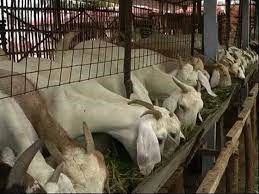Housing of Goat
Back
DIFFERENT TYPES OF SHED FOR GOAT
a) Loose Stalls for Pregnant Does and Kids




> Kids should be provided with separate loose stalls, away from adult females. The walls and doors of these stalls should be about 1•3 m high. A box barrel or a log is provided for exercise.
> One stall measuring 1•8 m2 can accommodate up to 10 kids. Such loose stalls are also suitable for goats at the time of kidding.
> All stalls should be provided with an enclosure in which the animals can be let loose during the day. This loose housing system reduces the housing cost and labour.
b) Exercise Paddock for Stall-fed Goats
> An enclosure measuring I2 m x 18 m is adequate for 100 to 125 goats. Such an enclosure or exercise paddock should be well fenced with strong woven wires which should not be far apart near the bottom.
> The exercise paddocks should be made bigger than the enclosures and should have some shade trees if the stock is to be maintained constantly in confinement. An extra-strong woven wire should be used, as goats have the habit of climbing fences and also of rubbing their bodies against them.
> Barbed wire should not be used so as to avoid injury to the udder and teats. It will be good if a box of 1 m x 1 m and 60 cm high and a stationary steel-drum or a log of 30 cm x 2•4 cm size is provided for their exercise.


c) Segregation Shed
> When the herd is large, provision for a small segregation shed, about' 3•6 m x 5 m, is very desirable.
> It should be built in the farther comer of the farm and provided with a well-fenced yard; it should be divided into two or three sections. Each stall as well as the yard should have a' separate watering arrangement.


d) Tethering

 > When one or two goats are to be kept and facilities for grazing are limited, tethering is convenient.
> This simple device has the advantage of keeping goats out-of-doors, and at same time on a limited area, although frequent changes of location become necessary.
> The animal is provided with a shelter with in its reach so that it may turn to it in the event of extreme heat or heavy rains.
> Goats have strong dislike for rain and for getting wet. The shelter should be temporary and preferably a portable one.
> The rope or chain used for tethering should be about 35 to 50cm long. The peg should be tethered only in the morning and evening, and kept in the shed during the mid-day.
> Tethering has also an important advantage of grazing the animal on a plot which is definitely known to be free from parasitic infections.
e) Elevated Platform
> When one or two goats are to be kept and facilities for grazing are limited, tethering is convenient.
> This simple device has the advantage of keeping goats out-of-doors, and at same time on a limited area, although frequent changes of location become necessary.
> The animal is provided with a shelter with in its reach so that it may turn to it in the event of extreme heat or heavy rains.
> Goats have strong dislike for rain and for getting wet. The shelter should be temporary and preferably a portable one.
> The rope or chain used for tethering should be about 35 to 50cm long. The peg should be tethered only in the morning and evening, and kept in the shed during the mid-day.
> Tethering has also an important advantage of grazing the animal on a plot which is definitely known to be free from parasitic infections.
e) Elevated Platform

 > In the tropics because of high temperature, heavy rainfall and the susceptibility of goats-to parasitism, the most practical goat houses are those which are raised above the ground level, are well ventilated, and have long eaves to prevent heavy rain showers to splash in from the sides.
> The floor must be strong (wooden strips with small slits in between) and the roof material should provide effective insulation from the solar radiation.
> The roofing material would be made of bamboo or tree leaves or earthen tiles which are cheap and practical. Provision must be made for collection of dung and urine periodically.
f) Hay Racks
> In the tropics because of high temperature, heavy rainfall and the susceptibility of goats-to parasitism, the most practical goat houses are those which are raised above the ground level, are well ventilated, and have long eaves to prevent heavy rain showers to splash in from the sides.
> The floor must be strong (wooden strips with small slits in between) and the roof material should provide effective insulation from the solar radiation.
> The roofing material would be made of bamboo or tree leaves or earthen tiles which are cheap and practical. Provision must be made for collection of dung and urine periodically.
f) Hay Racks

 > Goats are very wasteful and refuse to eat what has dropped down on the ground. Hay racks are very helpful for feeding.
> The bars of hay racks should not be more than 5 cm apart and there should be a wooden board, fixed about 15 cm below the rack, to catch what falls from the rack while the goat is feeding.
> Goats are very wasteful and refuse to eat what has dropped down on the ground. Hay racks are very helpful for feeding.
> The bars of hay racks should not be more than 5 cm apart and there should be a wooden board, fixed about 15 cm below the rack, to catch what falls from the rack while the goat is feeding.
